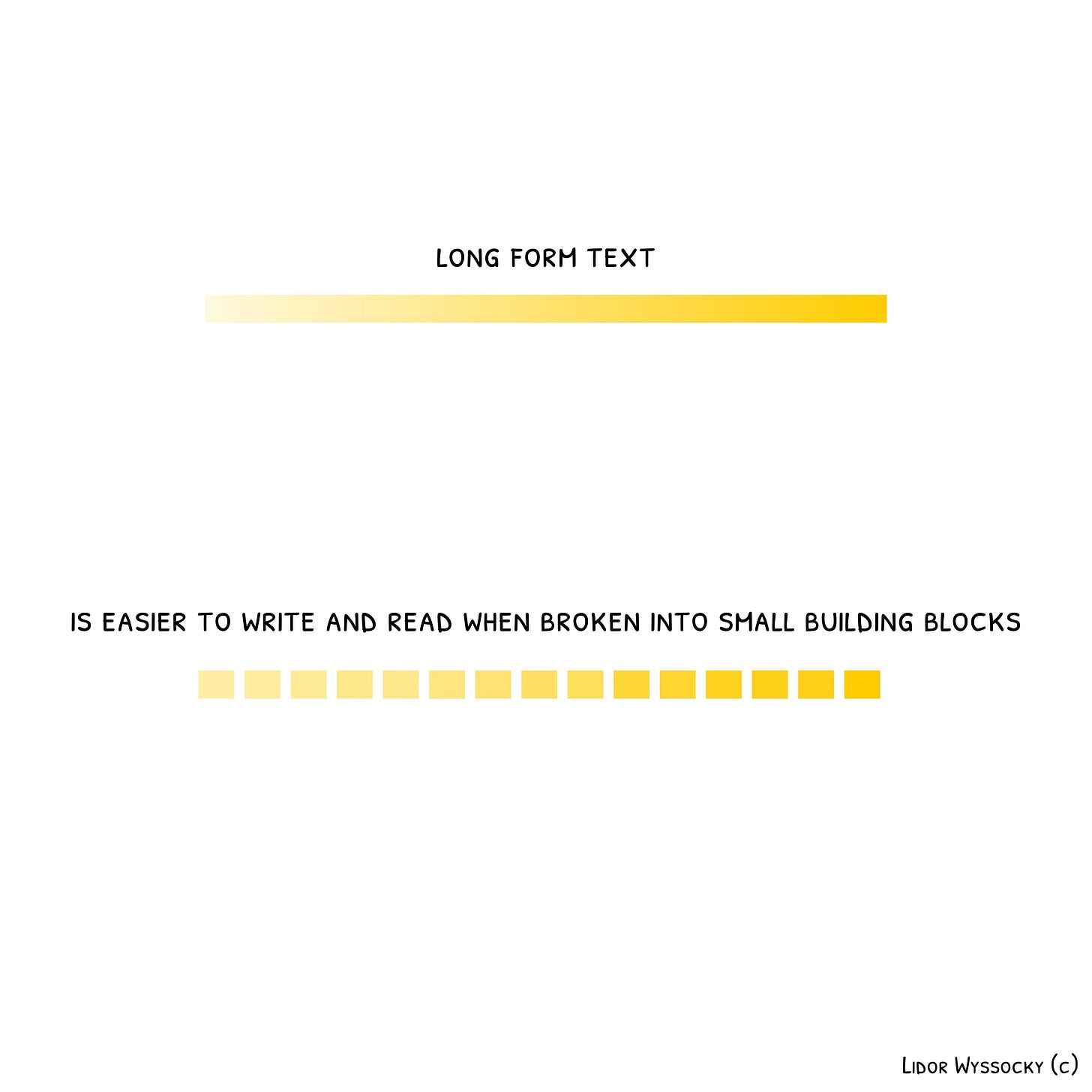Reflection on My Writing Process: Think Small
In the previous post, I described my most radical decision when working on my book: to start writing it again. Halfway through writing, I decided to structure it differently: short chapters, each focused on a single idea or practice you can apply to communicate better.
Thinking of my thesis as a structure made of tiny building blocks proved beneficial, both for me as the author and for my audience.
Let’s start with the fact that writing, especially if this is only one of the many things you do, is not easy. You have to find time and energy for it. When people ask for my advice on writing a book, I always say splitting the work into small increments is more manageable. Thinking about writing a book or even a chapter can be overwhelming, but if you can allocate relatively short time slots for writing, for example, 500 words at a time, you will make constant progress. Dividing a massive task into manageable smaller ones is always effective.
The challenge is that working on a long piece of text in multiple short sessions can break the flow of writing. You must recall where you’ve stopped and regain the momentum, the tone, and the logical flow in your next writing session. When I wrote an 8,000-word chapter for several weeks, regaining this momentum and maintaining the flow was not trivial.
But when I split the chapters into standalone building blocks that can each be written in no more than two writing sessions, everything flows more smoothly. I see tangible progress after just a couple of writing sessions in which I am focused on a single, coherent idea. The text flows more naturally, and the risk of losing momentum or wasting time recalling where I stopped is significantly reduced. Even if I take a long break, I can easily pick up where I’ve stopped. It’s practically a new chapter with a new idea.
All this was part of the plan. What I didn’t anticipate was how easy it would be to add things to the text or move things around. A few weeks ago, I realized I had an additional idea I would like to include in part of the book I’ve already written. Since the chapters were designed as small building blocks, nothing was simpler. I just added a new chapter between two existing ones. I didn’t have to change anything else. The smaller your building blocks are, the greater your flexibility in manipulating the text.
From my audience’s perspective, smaller chapters are easier to digest. You can read a few of them as one longer piece, but the real benefit of the building blocks approach is that it is easier to process and experiment with each idea after you read it. Most people find this approach more manageable. Similar to my small writing increments, adopting new practices and habits benefits from taking small steps that are easier to implement.
So, is this the ultimate way to structure a long-form text? Should we always write and publish the smallest building blocks possible? Well, yes and no. How the text is delivered is more of a tactical decision. Most non-fiction books have longer chapters than the ones I am writing. And yet, when I think of my text as a structured collection of small building blocks, I can seamlessly combine them into larger chapters if needed. Splitting my thesis into the smallest building blocks possible enables me to do whatever I want with them later with minimum effort. I can combine, rearrange, or reuse them to deliver different types of content. I can take such a building block and quickly turn it into a social post, for example. It encapsulates, after all, a single, relatively small idea.
Thinking small does not mean delivering small. Thinking small enables a more flexible structure, effective delivery, and stronger engagement. Depth is important. Not every idea can be squeezed into less than 2,000 words. But if you break down your idea into smaller logical blocks, it will be easier to contemplate and implement.
Unleash the power of Generative Communication and turn it into your superpower. I lead Generative Communication and Content-Shaping workshops and talks for teams and organizations.
With 1:1 mentoring, I help individuals communicate better, write better, and turn their ideas into an impact.
Drop me a message…


